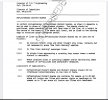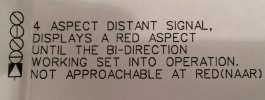Annetts key
Established Member
Distant signals don’t have red aspects / danger (stop) arms. The section and therefore the train are protected by a signal in rear of the fixed distant signal/sign that can show red/danger. So therefore no train can approach the fixed distant signal while there is a train ahead (beyond) it.Apologies if Im confused but a fixed distant will always allow a train to pass it. Therefore if a train is occupying the section then how would it be protected ? If that section was a terminal platform with a buffer stop. It doesn't matter if its permissive or not. A train aproaching the distant will have a clear aspect.
1) [fixed distant] (train) [buffers] doesn't appear to have any protection arrangements.
2) [fixed distant] [stop] (train) [buffers] makes more sense.
Shouldn't a fixed distant always be preceeded by another signal rather than a set of buffers ?
So:
[controlled signal with red/danger] — unknown distance — [fixed distant signal] — (service braking distance) [buffer stop].




